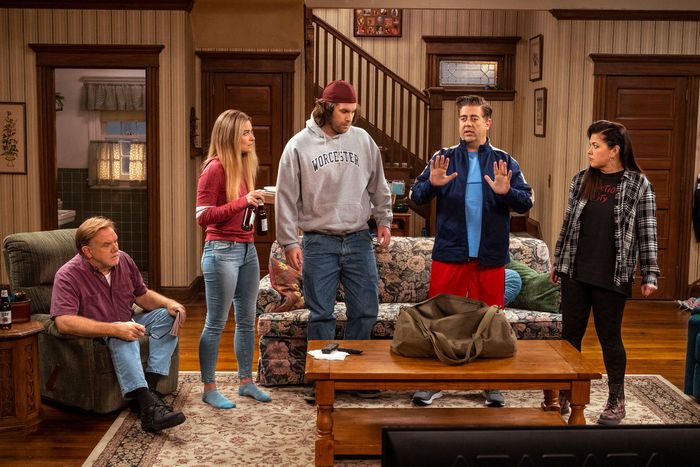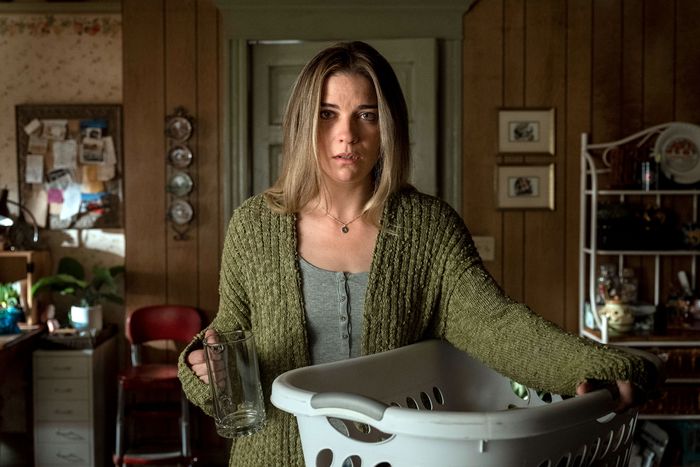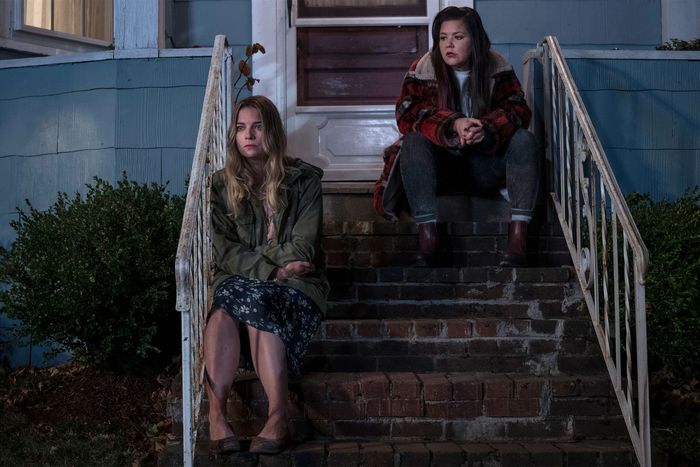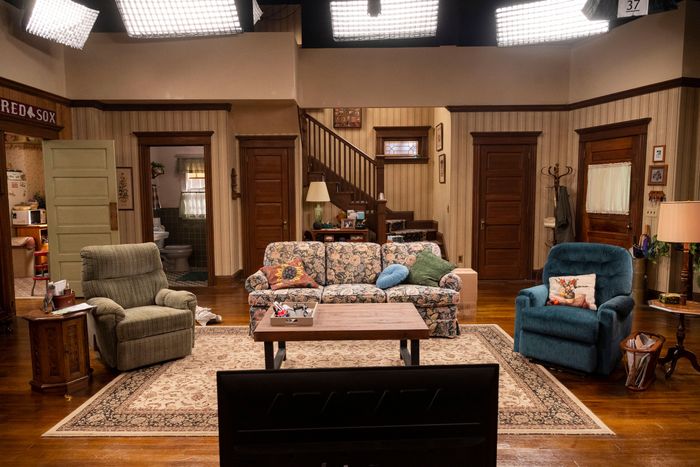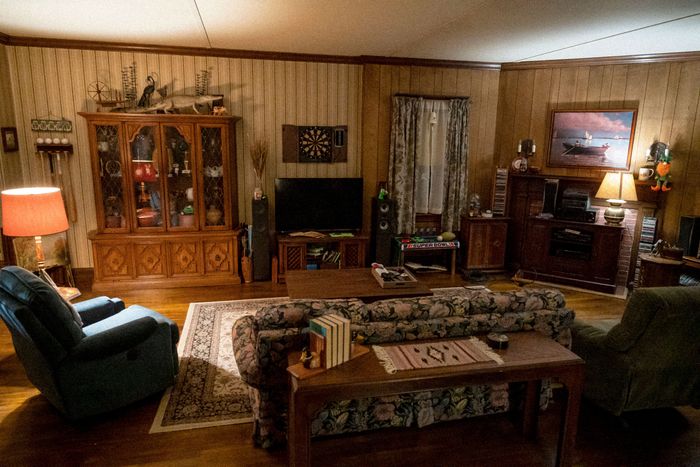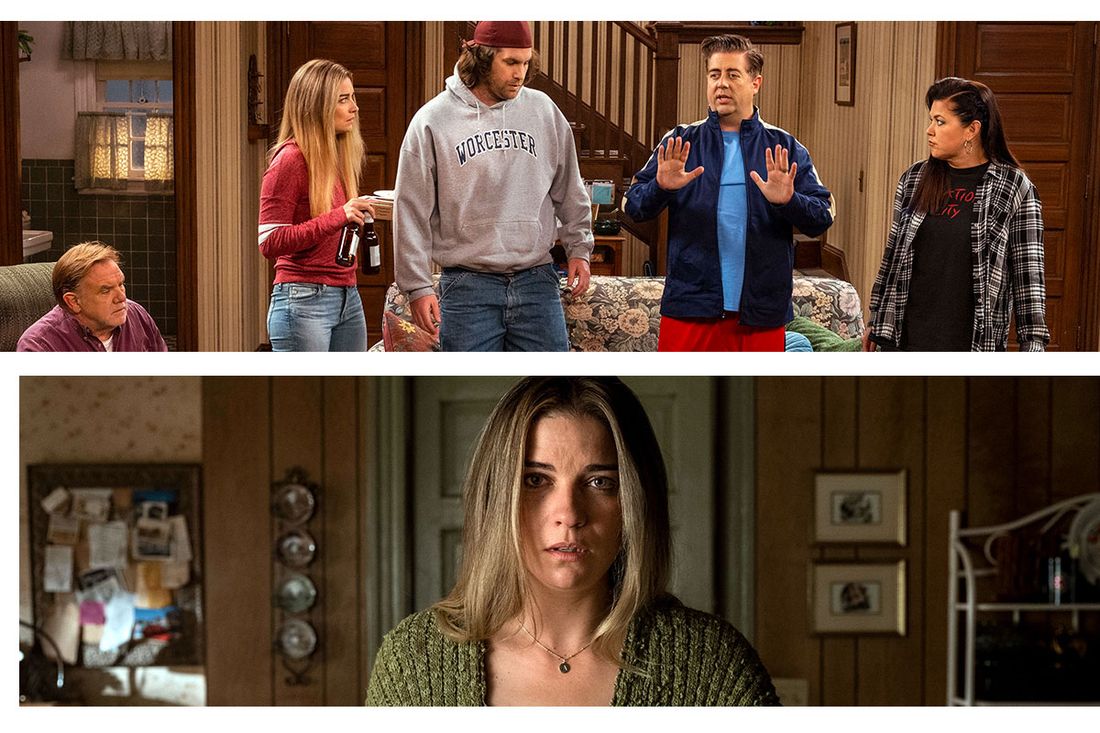
This article was originally published on June 17, 2021, shortly after Kevin Can F**k Himself premiered. Both seasons of the AMC series are now streaming on Netflix.
Valerie Armstrong was listening to a discussion on a podcast about how funny, talented actresses still get stuck auditioning for generic sitcom-wife roles when the opening scene of a television pilot started to stream in her head. “The first image came to me, which was just a sitcom wife walking offscreen with a thing of laundry and the audience laughing in the background,” she recalls. “But when she walks through the swinging door into the kitchen, we don’t stay with the funny husband. We follow her. The laugh track cuts, and we’re straight on her face and she’s miserable. I just saw her looking straight into the camera and saying, ‘I fucking hate my husband.’ ”
That flash of an opening scene was turned into an AMC show with an unapologetically blunt name: Kevin Can F**k Himself. The first episode opens almost exactly the way Armstrong had envisaged, with a wife named Allison McRoberts (Schitt’s Creek’s Annie Murphy) leaving her brightly lit living room, which is shot in a multi-camera format, and entering a more realistically rendered kitchen. The show never stops toggling between those two modes: one replicating familiar network sitcoms like Everybody Loves Raymond — centered here on Allison’s husband, the man-baby Kevin (Eric Petersen) — and one presented as a dark comedy revolving around Allison and shot in the grittier, more cinematic single-camera style of a show like Breaking Bad or Barry.
Their story lines run on separate but parallel tracks, informing and commenting on each other. As we learn the truth about Kevin and Allison’s life together in the single-cam scenes, what may seem like harmless comedy in Kevin Land — his habit of making important decisions without consulting his wife, a joke about how he got their mail carrier deported — begins to look more disturbing. When Allison learns Kevin has been secretly draining their savings for years, it prompts her to consider some, um, harsh ways to escape their marriage.
Armstrong acknowledges that the title is a riff on the defunct Kevin James sitcom Kevin Can Wait, an entry in the “zhlubby guy with a hot wife” genre that famously bumped off the wife character, played by Erinn Hayes, so that James’s former King of Queens co-star Leah Remini could be cast as the new female lead. But satire is not Armstrong’s goal. The more realistic half of Kevin serves a bigger purpose: to illuminate the misogyny that undergirds decades of American sitcoms and — via the evolving relationship between Allison and her next-door neighbor Patty (Mary Hollis Inboden) — ask how women can be better allies to one another. “The show, to me, is not about a toxic marriage,” says Armstrong. “It is not about Kevin. It is about how women can get each other out of toxic situations.”
Writing the show was a puzzle in which the multi-cam and single-cam plots became so intertwined that Armstrong admits they were like “a fishtail braid. You pull one thing and it all comes apart.” Switching back and forth so much was a risk — one false move could wreck the tone and all the plot machinations the writers had put in place. To avoid that, Armstrong says, she and the Kevin team needed to set “some hard-and-fast rules.”
Rule No. 1:
Take Sitcoms Seriously
For the multi-cam scenes, Armstrong and the writers set out to directly re-create that style without engaging in parody. “If you took those scenes out of the show and smooshed them together, you’d have yourself a 12-minute real episode of TV,” says showrunner Craig DiGregorio.
He and Armstrong staffed the writers’ room with people who had experience working in a mix of genres — drama, multi- and single-cam comedy — and they all spent time rewatching sitcoms like Last Man Standing and, yes, Kevin Can Wait and The King of Queens. The story lines they wrote for Kevin Can F**k Himself follow Allison’s husband and his ridiculous plans, like throwing an “anniversa-rager” or building an escape room in the basement. As in any broadcast-network sitcom, there are no curse words, with one minor exception toward the end of the season. (In the single-cam half: Definitely curse words.) Kevin is supported unconditionally by his father, Pete (Brian Howe), and his dim best friend, Neil (Alex Bonifer), who is Patty’s brother — a dynamic that turns arguments between Allison and Kevin into a three-against-one scenario. Armstrong and DiGregorio wanted this part of the show to be amusing enough to be credibly watchable and dismissive enough of its female characters to underline the show’s points.
Some of the most sexist jokes could easily have appeared in a ’90s sitcom. The pilot shows Allison breaking a glass beer mug three times: once when she’s alone, once in a fantasy sequence, and a third time in the multi-cam kitchen, where she’s surrounded by her husband, his father, Neil, and Patty. It’s clear that she has snapped, and her hand starts to bleed. But instead of expressing concern, Kevin makes a joke about her period: “It doesn’t mean you get to be moody. You’ve used that excuse once this month.”
While there is a meta aspect to these sequences, the characters never break the fourth wall. This part of the show is a metaphor for “the emotional and situational prison Allison finds herself in,” says Anna Dokoza, who directed episodes three through eight. Armstrong says it highlights “the benefit of the doubt we’ve given to guys like Kevin forever,” affording them an authority they haven’t earned.
Originally, the multi-cam parts of the show were slated to film in front of a full studio audience. But because shooting began last fall under covid protocols, a few masked, socially distanced laughers were brought in to watch. Armstrong found they immediately became protective of Allison. “Everybody went through covid watching Schitt’s Creek for comfort, so they were like, Who is this guy making a joke about our Annie Murphy? ” she says.
Rule No. 2:
The Single Cam Sets the Stakes
The single-cam side of Kevin Can F**k Himself is where the consequences of Kevin’s actions are laid bare, the spine around which the series is built. That’s where we find out about his financial betrayal and see how much Allison is breaking down in its wake; he has crushed her dreams of buying a nicer house, which she views as the ticket to the perfect life. It’s also where we see her and Patty become friends and put themselves in danger, buying and selling drugs and contemplating serious crimes.
While the multi-cam tends toward shots that capture the breadth of the set, the single cam is often lensed to communicate that we are now inside Allison’s head, seeing her hometown of Worcester, Massachusetts, as she sees it. The idea to focus single-cam scenes on shadows and imperfections came from the late filmmaker Lynn Shelton, who was deeply involved in the show’s early creative process and planned to direct the pilot. Production was supposed to begin in March 2020 but was postponed by the pandemic; in May 2020, Shelton died unexpectedly of acute myeloid leukemia. When Oz Rodriguez later took over directorial duties on the pilot, he and the team often placed Allison where she could never be in the multi-cam: in the center of the frame, with the camera zoomed in to capture every subtle change in her expression.
Noelle Valdivia, one of the show’s writers, says the staff focused on establishing Allison’s arc before looking for classic sitcom plots that could “elucidate her story and allow it to motivate her and expand on what she was feeling.” They worked tropes like “twins” and “fake funeral” — “anything that could have been on an episode of Punky Brewster” — into scripts where they could complement what was happening in the other part of the episode.
That approach allows the writers to show how the events on one side influence the other. When Kevin decides to roast a pig to use in a chili recipe, then abandons it in the yard, Allison and Patty find themselves staring at the animal still on its spit a day later. While the multi-cam presents this as funny, in the single cam “you see the reality of it,” says Armstrong. “That Allison has to clean it up, and it’s disgusting and rotting and probably going to sit there for another three days if she does nothing about it.”
Kevin and his sidekicks only appear in the single-cam scenes in Allison’s occasional fantasies. This “real” world belongs entirely to her and Patty, the only characters who move regularly between the two halves of the show. Inboden and Murphy both say the multi-cam scenes made them think about the actresses who had played the wife role in the past. “It was challenging to be a female in that environment after having looked through the filter of what Kevin Can F**k Himself is trying to do,” says Inboden. “It was hard to sit on the couch in that environment and not go, This is gross. This is unfair.”
Murphy recalls a day on the multi-cam set when they were shooting a scene in which Petersen had to regurgitate steak all over her while giving himself the Heimlich maneuver. “At the end of the day, I was like, Fuck this. It was a good look into the world of so many women who didn’t have the luxury of then going into a single-cam world and showing people an alternate side of themselves.”
“We have shattered the way you see the multi-cam experience now,” says Dokoza. “You can’t watch those scenes like you don’t know what’s happening in the single cam.”
Rule No. 3:
The Two Sides Must Stay Linked
When they first started discussing Kevin, Armstrong and DiGregorio imagined a show that felt like moving between an episode of Roseanne and David O. Russell’s movie The Fighter, two divergent glimpses of blue-collar family life. The transitions needed to be purposeful without being too drastic — “to cut seamlessly and just be something you don’t even think about” while you’re watching, says Dokoza.
“Audio really helps you get out of multi-cam and right into Allison’s point of view,” says Rodriguez. In the pilot, a ringing in Allison’s head often signals the switch. The slamming of a door in the multi-cam works as an effective way to cut to the single cam. There are also Easter eggs sprinkled throughout the multi-cam that confirm information we’ve learned elsewhere, like the brand-new sneakers Kevin is always wearing — evidence that he really has been spending all of the couple’s savings on frivolous things for himself.
Production designer Tony Fanning used the same sets for locations that show up in both formats, angling out the two sides for multi-cam purposes and sliding in a fourth wall and a ceiling for the single. Astonishingly, none of the other details, down to the table lamps, change at all. What does change is the way these environments are shot and lit: While the multi-cam makes the home look open and inviting, for the single cam Rodriguez and Dokoza chose angles that capture the fourth wall and the ceiling. Sunlight streaks in sparingly, making everything look dimmer and drearier.
Fanning had to carefully calibrate the color palette so it would work in both versions. “You couldn’t get too crazy with pattern and the brightness of color because it would look fake or false in the single-camera world,” he says. Paint, wallpaper, and other pieces were nicked and scuffed to appear worn and torn, but not so worn and torn that they look out of place in the multi-cam. Costumes similarly did double duty. In the pilot, Allison tears a hole in her sweater in the single cam, but we never see the snag in the multi-cam scenes; it’s covered by a jacket, and the cameras don’t zoom in close enough to capture it.
In so many ways, Kevin Can F**k Himself is telling its audience to look closer — at Allison, at jokes that punch down, at gender dynamics on TV and in real life, and at how human beings, women in particular, can do a better job of supporting one another. The series arrives during a pandemic that has caused particularly intense stress for women and might have already prompted some to think about the same issues that are plaguing Allison: what they want their lives or marriages to be and whether it’s even possible to get there from where they are now.
“I think if this show can make even one woman see herself and say, Oh, right. This is the life that I could have for the rest of my life, but I don’t want that. I want to change, then I think the show will have been a massive success,” says Murphy. She hopes that the opening scene, where Allison smashes her beer glass, will resonate with anyone who has kinda had it after the past year. “I wish for millions and millions and millions of women out there that they just had a nice, fake breakaway beer mug to shatter,” she says. “Because, ooh — that gets out a whole lot of pent-up aggression.”



